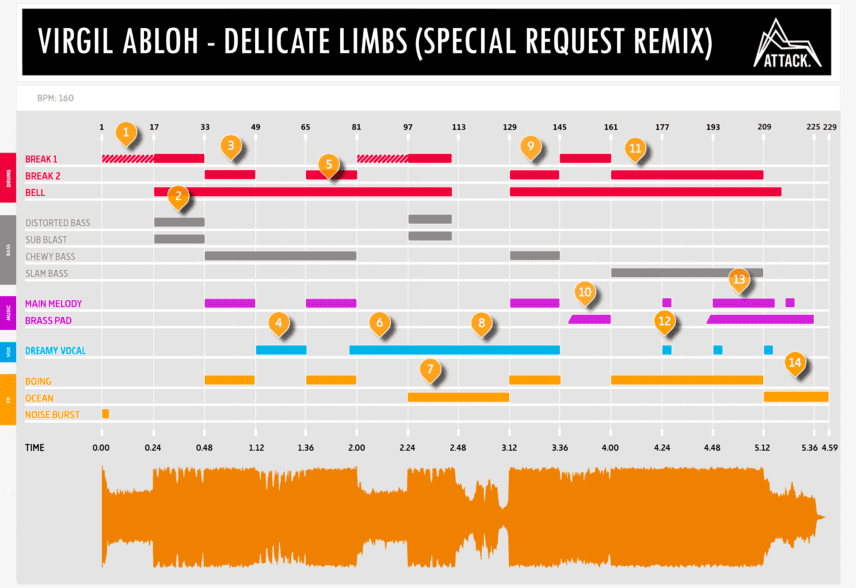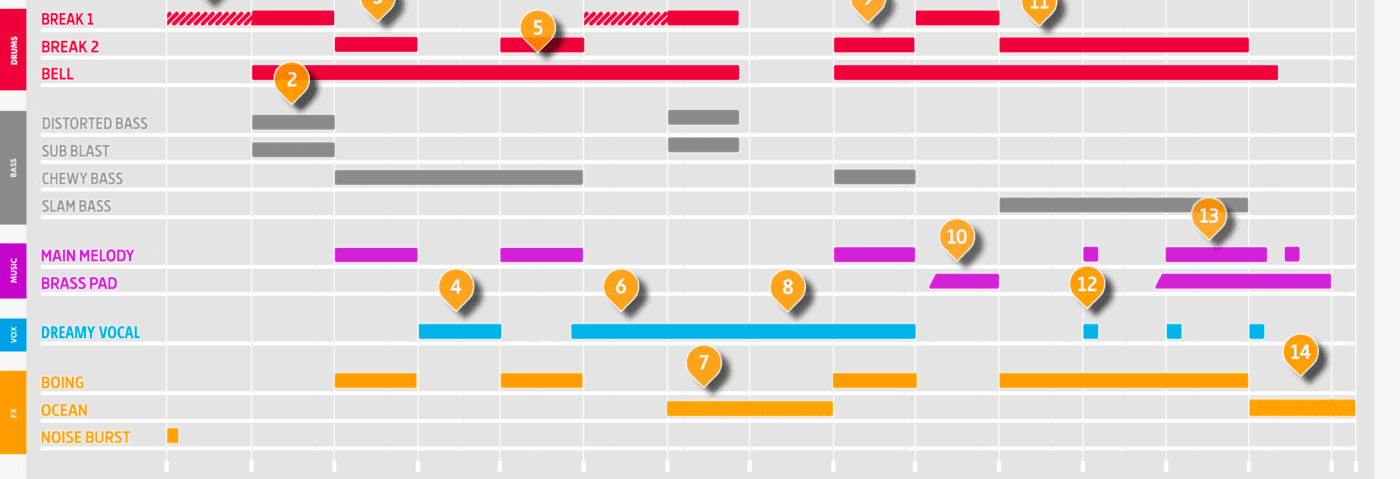We put Paul Woolford’s jungle remix of the R&B track under the microscope and see what makes it hit so hard.
Deconstructed is a series where we take apart the arrangement of a track. We examine the general flow of the song to see what makes it successful. This time, we’ve got the Special Request remix of Virgil Abloh’s ‘Delicate Limbs’ on the docket.
There’s a ridiculous amount of talent involved in this remix. The original version was done by modern day Renaissance man Virgil Abloh with assistance from future R&B genius serpentwithfeet. That right there is enough fire to ignite your iPhone but to make it even hotter, Special Request turned out a remix for the artistic director of Louis Vitton’s menswear collection and Kanye West collaborator.
A.K.A. Paul Woolford, Special Request works across styles and specializes in all things breakbeat, although he’s just as likely to bang out some skittery IDM as he is to reinvent jungle or breaks. His remix of ‘Delicate Limbs’ is typically genre-defining, with a flurry of chopped breaks coexisting with distorted bass and a moody pad.
Let’s go through the track section by section and see how Woolford uses the arrangement to his advantage.
The Track
The Arrangement

What’s Happening
1
When the 160bpm song kicks off, we know exactly where we are: in Special Request’s house. One listen to that distinctive break processing and there’s no doubt who’s answering the door. Woolford is a big fan of this delay processing and he’s used it on breaks in lots of tracks but the best known is probably ‘Spectral Frequency’. On ‘Delicate Limbs’, he applies it less as a way to hype up the track (although there is that aspect to it too) but to tweak it out. The original ‘Delicate Limbs’, like a lot of songs by serpentwithfeet, is pretty surreal, and Woolford keeps that dream-like feeling intact while also boosting the energy.
Notice how the break’s delay processing changes every four bars. This constant drum tweaking is something of a theme in Woolford’s music and especially in this remix. As he’s working with mainly samples of full breaks rather than one shots, and keeping things fairly minimal, he uses effects processing to prevent the song from becoming static and repetitive.
Also, note the low-passed white noise burst – almost an explosion – on the first beat. This is the only time we hear it but it does a good job of signalling the start of the track.
2
At bar 17, Woolford gives us the full version of the break he teased in the intro. It’s also processed, this time with lots of saturation, fully to the point of distortion. This is another of Woolford’s signatures, this overloaded hardware sound. There’s a slight amount of flanging happening on the break as well. This is doubly apparent at bars 24 and 32, when Woolford uses effects, mainly filtering and flange, to change the break into a kind of fill.
The start of every two-bar section has two bass sounds. On the top, there’s a distorted synth bass, while underneath, there’s a long and heavy sub blast.
Working alongside the rhythmic elements is a high, ethereal percussion sound, like sleigh bells shaken a single time. This is repeated at even intervals throughout the 16-bar section and treated with lots of reverb to create an atmosphere. This combination of heavy, distorted rhythm and dreamlike sounds will continue throughout the track.
3
Woolford is working with 16-bar groups in ‘Delicate Limbs’, each change happening after a predictable section. What is not always predictable, however, is how he changes things. The transition at bar 33 is particularly abrupt, moving from the previous section into one with entirely new drums, bass and melody.
Let’s start with the drums. Woolford alternates between two breaks, a chopped Amen and a second one with a prominent ride. Both are heavily processed with audible timestretching, another of Special Request’s calling cards. Check out the Amen snare climb that acts as a fill in bars 39 and 47. A delayed and processed boing sound hits at the end of every second break. Shades of The Prodigy?
The chewy bassline here is more melodic than the distorted blats in section 2 and serves to hold down the musical scale of the track. The song is in C minor, which classical composer Schubert called the key of the “love-sick soul”. It’s also known for representing “soft longing… and a passionate intensity”, according to the folks behind Mixed In Key. Seems perfect for this song (or really anything featuring serpentwithfeet).
Working in time with the bassline is a lovely melody that never overstays its welcome, adding harmonic flavour and then getting out of the way of the beats and bass.
The bell sound introduced in the previous section continues.
4
As echoes of the final boing in section 3 fade out, Woolford introduces the vocal taken from the original song. He’s soaked it in reverb, really upping the dream-like feeling. The vocals also jump around in the stereo spectrum – sometimes they’re right in the middle, sometimes to the right while background vocals show up on the left. It’s all part of the vibe.
The bassline continues while the bell sound keeps doing its thing, adding to the atmosphere.
5
After 16 bars, the breaks, melody and boing jump back in and largely repeat section 3. Notice how the bell sound doubles up with the rides in the second break.
The vocals come back at bar 78, a snippet from the original with unusual pitch bending.
6
Is it the chorus? Maybe it’s the closest we’ll get to a chorus in a Special Request track. Anyway, Woolford lets the words, “Don’t let my delicate limbs deceive you” play just once at the beginning of the section. But forget that, because the processed break from the beginning of the song is back. It runs through the same four-bar progression as the intro. The bell sound keeps going as well.
7
At bar 97 we get the beat and bass combo from section 2 again, this time with a full verse – again, absolutely rinsed in reverb – running alongside. With the bell sound still going, it creates a real sense of atmosphere. Woolford doubles down on this by fading in audio recorded at the beach, with waves and birds clearly audible. This is not your dad’s jungle. This is some next-level business.
8
The break and bass stop abruptly at bar 112, a full bar before the expected turnaround point of bar 113. This is to give importance to the lyric, “The sea lacks charm when you’re not there.” The beach sounds now make poignant sense.
As the waves continue to lap at the song’s metaphysical shore, Woolford lets the chorus play, eventually dubbing it out with tape echo. The echo repeats seem to fade but then return in volume, building to the turnaround.
9
As the echo repeats fade out, we get a duplicate of the main section, with alternating Amen and ride break, chewy bass, melody, and bell.
10
It’s time for another change. The first break returns, this time really blown out with saturation and flange. As the mood-enhancing bell continues, Woolford fades in a very mournful, Aphex Twin-sounding brass pad. Now the “love-sick soul” C minor feeling is really apparent.
It might be surprising that a jungle producer would use IDM-style sounds in his music, but Woolford isn’t your typical one-genre composer. “Everything I do… are purely things that I feel,” he told us in 2017. “Jungle is only one part of what Special Request is, and I’ve been into that since it was developing rapidly from hardcore.
“I know people like to identify with something specific, at a specific point in time when the media throws up arrows at the sound du jour, and I understand that. But my relationship with it is not that I see things, labels and scenes and want to be involved with them because of that, I’m just doing what I feel at all times.”
This remix is the perfect example of that. It doesn’t adhere to genre conventions and it doesn’t have to. It does everything on its own terms.
11
Back to the song. Just when you thought it was time to take out some tissues and have a good cry for lost love, Woolford upends the table with a slamming bassline. Powering over the duelling breaks, it doubles up the chewy bass with a new, distorted line. The bell continues underneath and a reverse-reverb snippet of the vocal acts as a riser to take us into the next section.
12
Everything continues from the previous section, with a hint of the melody showing up to remind us that once upon a time this was a moody song. A nonsensical snippet of the vocal jumps in to add to the confusion.
At the end of the 16-bar section, the brass sound fades back in and serpentwithfeet suddenly sings, “But if the magic fades”.
13
Everything continues. The fact that Woolford has not changed the arrangement in the last sections indicates that he wants to keep building tension. He brings back the main melody as well and gives us a few more surreal bits of the vocal.
While not really part of the arrangement, we just have to point out how gloriously saturated everything is at this point. It’s overloaded to the point of details becoming inaudible but that’s the idea. It adds to the excitement.
14
When the storm finally breaks, we get a few more dreamy words from serpentwithfet – again dubbed out with tape echo – and a final shake of the bell and sprinkle of the main melody. As the Aphex brass loops, the beach sounds return. They continue past everything else, fading out on an atmospheric note.
What a track.
